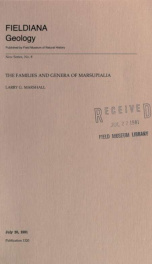Members of the extinct marsupial family Polydolopidae (superfamily Polydolopoidea) are known in South America from beds of Riochican (middle to late Paleocene), Casamayoran (early Eocene), and Mustersan (middle Eocene) age in Patagonia, southern Argentina; from beds of Riochican age in Brazil; and apparently from beds of Deseadan (early Oligocene) age in Bolivia. Five genera and 13 species, grouped in two subfamilies, are recognized. The Epidolopinae include Epidolops ameghinoi Paula Couto, 1952, from Riochican beds in Brazil, and an unnamed and undescribed epidolopine (apparently referrable to Epidolops) from Riochican beds in southern Argentina. The Polydolopinae include Polydolops clavulus meghino, 1902b (Casamayoran); P. kamektsen Simpson, 1935a (Riochican); P. rothi Simpson, 1936 (Riochican); P. winecage Simpson, 1935a (Riochican); P. serra Ameghino, 1902b (Casamayoran); P. thomasi Ameghino, 1897 (Casamayoran); P. mayoi Odreman Rivas, 1978 (Mustersan); Pseudolops princeps Ameghino, 1902b (Casamayoran); Amphidolops yapa (Simpson, 1935a) (Riochican); A. serrula Ameghino, 1902b (Casamayoran); Eudolops tetragonus Ameghino, 1897 (Casamayoran); and E. hernandezi sp. nov. (Casamayoran) -- all from Patagonia, southern Argentina. A specimen from beds of Deseadan age in Bolivia is tentatively referred to Polydolops? sp. indet. -- The species and genera are readily distinguished on the basis of absolute and relative size, structure of cheek teeth, presence or absence of various teeth, and formation by certain teeth of the "plagiaulacoid" or bladelike elements in the dentition (e.g., P2 and P3/P3 and trigonid of M1 -- Polydolops, Eudolops; P3/P3 and trigonid of M1 -- Amphidolops; P3/P3 -- Epidolops). An attempt is made to demonstrate that the large procumbent lower tooth in polydolopids is the canine and not an incisor. -- A historical review is given of polydolopid systematics. Nomenclature and relationships of included taxa are stabilized and clarified. Taxonomic limits of the Polydolopidae are defined; the group is shown to be monophyletic in origin. It is concluded that the Polydolopoidea and Caenolestoidea evolved independently from didelphoidlike ancestors in South America: any specializations shared by these groups, either with one another or with Australasian Phalangeroidea, are the result of convergence in evolution Includes bibliographical references (p. 89-91) Members of the extinct marsupial family Polydolopidae (superfamily Polydolopoidea) are known in South America from beds of Riochican (middle to late Paleocene), Casamayoran (early Eocene), and Mustersan (middle Eocene) age in Patagonia, southern Argentina; from beds of Riochican age in Brazil; and apparently from beds of Deseadan (early Oligocene) age in Bolivia. Five genera and 13 species, grouped in two subfamilies, are recognized. The Epidolopinae include Epidolops ameghinoi Paula Couto, 1952, from Riochican beds in Brazil, and an unnamed and undescribed epidolopine (apparently referrable to Epidolops) from Riochican beds in southern Argentina. The Polydolopinae include Polydolops clavulus meghino, 1902b (Casamayoran); P. kamektsen Simpson, 1935a (Riochican); P. rothi Simpson, 1936 (Riochican); P. winecage Simpson, 1935a (Riochican); P. serra Ameghino, 1902b (Casamayoran); P. thomasi Ameghino, 1897 (Casamayoran); P. mayoi Odreman Rivas, 1978 (Mustersan); Pseudolops princeps Ameghino, 1902b (Casamayoran); Amphidolops yapa (Simpson, 1935a) (Riochican); A. serrula Ameghino, 1902b (Casamayoran); Eudolops tetragonus Ameghino, 1897 (Casamayoran); and E. hernandezi sp. nov. (Casamayoran) -- all from Patagonia, southern Argentina. A specimen from beds of Deseadan age in Bolivia is tentatively referred to Polydolops? sp. indet. -- The species and genera are readily distinguished on the basis of absolute and relative size, structure of cheek teeth, presence or absence of various teeth, and formation by certain teeth of the "plagiaulacoid" or bladelike elements in the dentition (e.g., P2 and P3/P3 and trigonid of M1 -- Polydolops, Eudolops; P3/P3 and trigonid of M1 -- Amphidolops; P3/P3 -- Epidolops). An attempt is made to demonstrate that the large procumbent lower tooth in polydolopids is the canine and not an incisor. -- A historical review is given of polydolopid systematics. Nomenclature and relationships of included taxa are stabilized and clarified. Taxonomic limits of the Polydolopidae are defined; the group is shown to be monophyletic in origin. It is concluded that the Polydolopoidea and Caenolestoidea evolved independently from didelphoidlike ancestors in South America: any specializations shared by these groups, either with one another or with Australasian Phalangeroidea, are the result of convergence in evolution Fieldiana series has been published as Geological Series by Field Columbian Museum (1895-1909) and Field Museum of Natural History (1909-1943), and as Fieldiana: Geology by Chicago Natural History Museum (1945-1966) and Field Museum of Natural History (1966-1978). Fieldiana Geology New Series No. 1 began June 29, 1979






